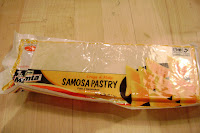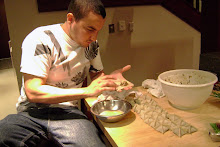
The artistry of Asian food has always inspired me. So clean, so simple, so pure... yet satisfyingly good. This was the recipe that jumped up to me from The Book Lover's Cookbook. This is a play of mine on Tiajin Dumplings p.57-58
For this recipe you will need: yields about 45 dumplings

1 pound ground pork
1/4 pound raw shrimp, deveined, shelled and
chopped
1 teaspoon ground coriander
1/4 cup green onions, thinly sliced
4 teaspoons chives, finely chopped
3 tablespoons garlic, minced
1 teaspoon ground black pepper
1 tablespoon sugar
1/4 cup soy sauce
1/2 teaspoon ground ginger (I use 1 tablespoon of
fresh)
1/4 cup coconut milk
1 pack of wonton wrappers
This recipe is already doubled.

I found pork trimmings at the grocery store for cheap, works perfect. Had to chop it up.
Combine:
pork, shrimp, green onions, chives,

ginger, garlic, sugar, coriander, pepper

soy sauce, coconut milk,

mix thoroughly.

While waiting for the flavors to melt together, we work on the dipping sauce

1/4 cup soy sauce
1 tablespoon toasted sesame oil
2 tablespoons rice vinegar
1 tablespoon vegetable oil
1 teaspoon sugar
some left over sliced green onions and chives for garnish
The wonton wrappers I am using were found in on the produce aisle while in some places would have them in the freezers. If you cant find them, I found by trial and error that samosa pastry works as an acceptable substitution. The dumplings here up top are made with samosa pastry. Just take out, keep moist and cut into squares.

To start making the dumplings, start with a clean dry surface. Work with a couple of wrappers at a time and keep the rest covered with a damp towel. Have your, filling, wrappers, scoop spoon and water or egg wash for sealing.
1. Place wrapper on clean dry surface or flat on your hand.
2. Use a scoop to place about a tablespoon of filling on the center of the square.
3. Help seal the edges by using a egg wash or
plain water on all four edges.
4. Pinch opposite corners together just at the tip.
5. Repeat on last corners.
6. Finished dumplings should be even in size.
Make sure you pinch the edges firmly,they must be flat and sealed.
The recipe in the book calls for cabbage leaves or parchment paper to steam your dumplings. That is the more traditional way and how they are usually eaten. But I am playing with another technique that just requires oil, water and cornstarch.

In a hot saute pan, add a dab of vegetable oil and sesame oil.
Place the dumplings in the pan and start browning.
Once browned it's time for steaming

Make a slurry with the water and cornstarch and add about 1/4 cup to the pan.
Cover quickly and steam for two minutes

Uncover and keep on heat to let the rest of the moisture from the slurry evaporate
You want a cracker like bottom layer. The juice and fat from some of the dumplings will ooze out and flavor the base. This is mainly for texture.

All the dumplings should come out in a single solid layer no matter if it was done in a non-stick pan or not.

Cut the individual dumplings apart leaving part of the base
Serve hot with your dipping sauce and enjoy this little morsel of art!





 Therapy... These can be frozen, refrigerated or cooked right away.
Therapy... These can be frozen, refrigerated or cooked right away.


